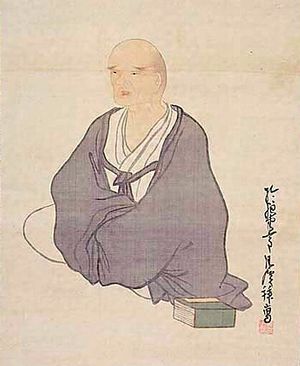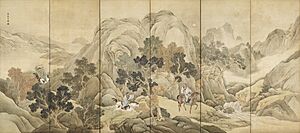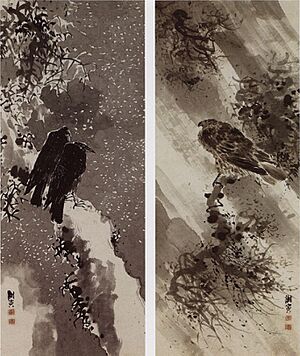Yosa Buson facts for kids
Yosa Buson or Yosa no Buson (与謝 蕪村, 1716 – January 17, 1784) was a famous Japanese poet and painter from the Edo period (1603-1868). He is considered one of the greatest poets of his time, alongside Matsuo Bashō and Kobayashi Issa. Buson was also known for his unique art style called haiga, which combines paintings with haiku poems. He also wrote a type of prose called haibun and experimented with a mix of Chinese and Japanese poetry styles.
Contents
Who Was Yosa Buson?
Early Life and Learning
Buson was born in a village called Kema in Settsu Province, which is now part of Osaka. His first family name was Taniguchi. Buson didn't talk much about his childhood. It is believed that his mother was a worker from a place called Yoza. There's a story that young Buson was cared for at a temple in Yosano. Later, when he returned, he gave the temple a special folding screen painting as a gift.
Around the age of 20, Buson moved to Edo (which is now Tokyo). There, he learned how to write poetry from a master named Hayano Hajin. Hajin taught in a house called Yahantei, meaning "Midnight Pavilion." After Hajin passed away, Buson moved to Shimōsa Province (now Ibaraki Prefecture).
Buson's Travels and New Name
Buson admired another famous poet, Matsuo Bashō. He decided to travel through the northern parts of Honshū island, just like Bashō did. These travels inspired Bashō's famous travel diary, Oku no Hosomichi (The Narrow Road to the Interior). Buson published his own travel notes in 1744. This was the first time he used the name Buson for his published works.
After traveling around Japan, including places like Tango (northern Kyoto Prefecture) and Sanuki Province (now Kagawa Prefecture), Buson settled down in the city of Kyoto when he was 42. Around this time, he started using the name Yosa. He chose this name from his mother's birthplace, Yosa in Tango Province.
Between 1754 and 1757, Buson worked on a collection of picture scrolls in the haiga style. This collection is known as Buson yōkai emaki.
Buson got married at 45 and had a daughter named Kuno. When he was 51, he went to Sanuki Province to work on many new art pieces.
Later Years and Legacy
Buson later returned to Kyoto. He continued to write and teach poetry at a place called the Sumiya. He taught his students by using the works of four of Bashō's best students as examples: Kikaku, Kyorai, Ransetsu, and Sodō. In 1770, he took on the poetry name Yahantei II, which was the same name his old teacher Hajin used.
Buson passed away at the age of 68. He was buried at Konpuku-ji temple in Kyoto.
Today, Buson's amazing artwork can be found in many museums around the world. These include the Seattle Art Museum, the Metropolitan Museum of Art, the University of Michigan Museum of Art, the Harvard Art Museums, the Worcester Art Museum, the Kimbell Art Museum, and the British Museum.
Buson's Poems
Buson wrote many beautiful poems, especially haiku. Here are a few examples:
- 隅々に残る寒さや梅の花
- Sumizumi ni nokoru samusa ya ume no hana
- In nooks and corners
- Cold remains:
- Flowers of the plum
- (translated by RH Blyth)
Peony Petals
Peony petals
fall, two or three
on each other
Other Haiku
the morning glory—
in each flower, the color
of a deep pool
spring drizzle
barely enough to moisten
seashells on the beach
See also
 In Spanish: Yosa Buson para niños
In Spanish: Yosa Buson para niños
- Buson yōkai emaki, a special picture scroll by Buson




